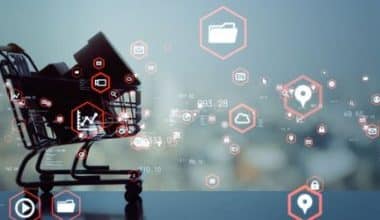Consider the last time you made a major decision for your retail store. Did you make any educated guesses? If that’s the case, you shouldn’t have. Even if your intuition was correct, it’s a risky way to manage a firm. The majority of retailers do not. The global retail analytics sector, valued at $8.64 billion, assists retailers by providing the data they need to make better decisions. Using data to manage a profitable retail business takes the guesswork out of everything from determining where to locate your next store to prioritizing inventory restocks. Not sure where to begin? This article discusses the sorts of retail analytics you should consult while making decisions, along with tools and examples to demonstrate each statistic in action.
What is Retail Data Analytics?
Retail data analytics is the act of gathering and analyzing retail data (such as sales, inventory, pricing, and so on) in order to identify trends, forecast outcomes, and make better, more lucrative business decisions.
When done correctly, data analytics enables retailers to get greater insight into the performance of their stores, products, customers, and vendors — and use that understanding to increase profitability.
Almost all merchants use data analytics in some way, even if it’s only examining sales figures in Excel.
However, there is a significant difference between an analyst using Excel to pore through spreadsheets and employing purpose-built AI to evaluate billions of data points simultaneously.
To appreciate this distinction, you must first understand the four categories of retail data analytics.
Types of Retail Data Analytics
There are four basic types of retail data analytics: descriptive analytics, which reflect and explain past performance; diagnostic analytics, which identifies the core cause of a given problem; predictive analytics, which estimates future results; and prescriptive analytics, which suggest next moves. Each of the four techniques is discussed in greater detail below.
#1.Descriptive Analytics
Descriptive analytics serves as the foundation for more sophisticated types of analytics, such as those listed below. It answers fundamental queries like “how many, when, where, and what”—the substance of basic business intelligence tools and dashboards that deliver weekly sales and inventory statistics.
#2. Diagnostic Analytics
Diagnostic analytics assists retail firms in identifying and analyzing issues that may be impeding performance. Retailers can acquire a more thorough understanding of the core causes of problems they experience by merging data from numerous sources, such as consumer feedback, financial performance, and operational analytics.
#3. Predictive Analytics
Predictive analytics assists merchants in forecasting future occurrences based on a variety of factors such as weather, economic trends, supply chain interruptions, and new competitive challenges. This strategy frequently takes the shape of a what-if analysis, which allows a retailer to map out what would happen if it offered a 10% discount versus a 15% discount on a product, or anticipate when it would run out of stock based on a particular set of alternative actions.
#4. Prescriptive Analytics
Prescriptive analytics is the application of AI and big data to take predictive analytics results and prescribe actions. For example, prescriptive analytics, for example, can provide customer support agents with suggested offers that they can pass along to consumers on the fly, such as an upsell based on previous purchase history or a cross-sell to answer a new customer query.
Retail Data Analytics Application Examples
One of the most important reasons to utilize data analytics to drive decision-making is to ensure that your conclusions are founded on actual truth (cold, hard figures), rather than someone’s perspective of reality.
Analytics can also help you understand your firm in far greater detail than you could otherwise.
In practice, a shop can utilize data analytics to:
- Understand the typical order’s value and quantity of products sold.
- Determine which products sell the most, which sell the least, and everything in between.
- Determine your most valuable customers.
- Discover your genuine demand as well as previous missed sales.
- Determine the best-proposed order quantities and make recommendations on buy quantities and allocations.
- Determine the best price for a specific product in each given area.
These (and other) insights can help you better understand your company’s metrics and develop strategies that will bring you where you want to go.
Analyzing data should become a vital component of your firm as it grows in order to improve decision-making and develop effective retailing tactics.
It’s no surprise, then, that the retail analytics solutions sector is big and booming. We’ll go through some of these apps, how they work, and what benefits you could get from utilizing them.
#1. Business Intelligence
Many firms use Business Intelligence tools to properly manage and organize their data. BI tools are an example of descriptive analytics because they help you arrange and visualize your data.
Many shops undertake basic business intelligence (BI) utilizing native ERP (Enterprise Resource Planning) system features or by importing data straight into Microsoft Excel.
Slightly more sophisticated retailers will employ BI software such as:
- Microsoft Power BI
- Tableau
- SAP
- QlikView
- Spark by Apache
These applications provide access to many data sources, appealing visuals, and some data manipulation.
The most complex BI typically comprises data scientists who use programming languages (such as Python) that provide additional freedom for data processing, visualization, and modeling.
While useful, many of the examples above necessitate a significant amount of human intervention and are time-consuming to manage. This is especially true for medium to large retailers with hundreds or thousands of outlets (and tens of thousands to hundreds of thousands of goods). This is why many retailers employ analysts assigned to each department to compile reports.
Advanced analytics tools, such as Retalon, may typically automate the majority of the manual, repetitive procedures associated with standard BI methods due to their sophistication.
#2. Sales Forecasting
Sales forecasting sales is another common use of data analytics in retail.
Simply described, sales forecasting is the act of analyzing previous sales data, identifying trends, and projecting them into the future in order to estimate sales.
This assists merchants with everything from inventory purchases and OTB budget management to defining high-level financial targets for the organization.
Sales forecasting, as the name implies, is predictive in nature – and it is the most basic sort of predictive analytics employed by retailers.
There are numerous techniques for forecasting sales because firms have been seeking to do so for centuries:
- Using last year’s sales figures to forecast sales for the current year
- Surveys, observations, and other forms of market research
- Estimates from pundits
- Excel statistical models
- Specialized software
Many stores have developed their own in-house solution for forecasting future sales, typically integrating dozens (if not hundreds) of Excel sheets, ERP capabilities, specialised software, and teams of analysts.
While sales forecasting is the foundation of many retail planning processes, it is possibly the most important area of data analytics that need improvement. This is due to the fact that sales forecasting is frequently wrong and fails to account for the complexities of the retail industry.
For example, if a merchant sold out of a product last year, conventional sales forecasting methodologies would tell them to repeat the error – even though they could possibly sell significantly more.
As a result, most sales forecasting has fallen out of favor, with more complex predictive analytics taking its place.
#3. Demand Forecasting
As previously said, demand forecasting is a far more advanced sort of predictive analytics that merchants employ.
Demand forecasting, as opposed to attempting to estimate sales using only historical sales data, employs a far larger range of data to compute demand for each product, at each store, at precise time intervals. Demand forecasting is thus far more accurate than typical sales forecasting.
More information regarding sales forecasting vs. demand forecasting may be found here.
In summary, the key advantages of this form of retail analytics are as follows:
- More precise forecasting of the business’s future status
- Making simulations or “what-if” scenarios
- Capability to adapt on the fly when conditions change on the ground
- Unification of critical retail functions (for example, promotions and inventory management)
As is customary, there are numerous methods for forecasting demand. Retailers can utilize the following, in descending order of sophistication:
- Excel spreadsheets containing statistical models
- General Analytics and Statistical Modeling Software
- AI-powered retail analytics software
Read Also: ONLINE RETAIL: All You Need To Know
While the first two alternatives are adequate for smaller businesses, they become difficult (if not impossible) to employ with very big data sets (such as those found in medium to large retailers).
This is due to the fact that demand forecasting uses data from sources other than sales data.
- Pricing history
- Past Inventory
- The range and richness of the assortment
- Product groups and families
- Seasonality
- Supply chain inconsistency
- Activity of competitors
- Consumer preferences
- Etc.
Imagine manually compiling, analyzing, and modeling all of this data for billions of distinct Store / SKU combinations.
Finding a retail predictive analytics software vendor with a proven track record of dealing with retailers in their vertical is the best method for retailers to employ demand forecasting.
Using customized software like this provides numerous advantages to shops.
For example, you can experiment with different variables such as product price, new store openings, new product launches (and others) to see what effect they have on your bottom line KPIs – and then modify your inventory, prices, or marketing strategy accordingly.
#4. Unified Advanced Retail Analytics
This is the most potent type of analytics, with the best ROI when used appropriately.
Unified advanced analytics, which falls under the fourth type of analytics (prescriptive analytics), strives to combine the benefits of business intelligence, strong diagnostics, and accurate demand forecasts with intelligent automation that proposes the most lucrative activities across the business.
Decent unified analytics software will do the following:
- Automate reporting and data visualization.
- Forecast demand for every product in every store at certain times.
- Allow for flexible simulations and “what-if” scenarios for new product launches, retail openings, and other similar situations.
- Thousands (if not millions) of micro-optimizations across selection, allocation, pricing, and so on are automatically recommended.
- All modifications and updates must be reconciled across all departments and data sources.
This form of analytics can only be given by software suppliers who specialize in advanced retail analytics due to its complexity and specialty.
It not only automates hundreds of repetitive processes (compiling reports, consolidating data amongst departments, evaluating, and so on), but it also optimizes at a granularity that human analysts just cannot match.
This type of advanced data analytics is provided by a variety of solutions, including Retalon’s retail analytics platform, which uses highly accurate demand forecasting and advanced AI to deliver hundreds, thousands, or even millions of granular improvements that enhance the bottom line.
Furthermore, this sort of software is highly adaptable and may be set to accept certain suggestions automatically while requiring human permission for others for greater control.
When Is It Time to Upgrade Your Retail Analytics?
Any medium to large retail business that wants to be successful in the long run must use some sort of data analytics. This is because correct insights must be obtained proactively in order to provide the appropriate product, to the right location, at the right time, and in the right quantity.
Even if you’re already using analytics, you’ll probably want to update sooner or later to keep ahead of the competition.
Typically, as your firm grows, so will the volume of data and the complexity of the decisions involved.
But what if you have way too much data and have no idea what to do with it?
To determine whether it’s time to modernize your data analytics tools, start by asking the following questions:
- How far should I delve into the data? Are my difficulties’ solutions obvious?
- Is it common for me to run across exceptions and have to manually revise my forecasts?
- Are my analytics tools in different retail functions accounting for one another?
- Is it possible that I’m making the same mistakes year after year?
- Do I still have concerns with inventory distortion, such as lost sales, overstock, and out-of-stocks?
- Do I have too many markdowns towards the end of the season?
- Is there a good approach to cope with new products that have no sales history?
The answers to these questions will help you determine whether you should improve your analytics approach.
However, avoid the all-too-common retail analysis paralysis pitfall.
Retailers who invest in advanced analytics are stealing market share from those who are still undecided. As we approach the digital age of commerce, powerful data analytics and retail AI are no longer a “want” but a “need.”
The Advantages of Retail Analytics
Retail analytics is a collection of tools used by retailers to enhance sales, minimize overhead and labor expenses, and improve profits. Retail analytics can help achieve these objectives in a number of ways, including:
#1. Reducing stockouts and the need for discounts
Retail analytics assists users in understanding demand trends so that they have enough products on hand but not so much that they have to resort to harsh discounts to get rid of surplus inventory. The use of analytics to determine how rapidly a product is consumed is a common practice.
#2. Improving personalization:
Analytics enables merchants to better understand their consumers’ preferences and, as a result, capture more demand than competitors. A book retailer, for example, can use purchasing history to notify consumers who have expressed an interest in American history when a new book by historian Ron Chernow becomes available for preorder.
#3. Improving pricing decisions
By synthesizing a range of indicators, such as abandoned shopping carts, competition pricing information, and the cost of products sold, data analytics can assist businesses in setting the ideal prices for their goods. Retailers can maximize profits by not charging prices that are higher than the market will bear or lower than what customers are prepared to pay.
#4. Improving product allocations
Analytics may assist retailers in determining how to allocate products across geographic regions, distribution facilities, and storefronts, hence eliminating unnecessary transportation costs. For example, a sports apparel shop can utilize analytics to see how a two-degree variation in temperature affects sales of thermal undershirts and allocate more of such items to a distribution facility nearest to locations expected to have cooler temperatures during a given winter.
Retail Analytics Software
Retail analytics is based on data collected in a variety of ways, including physical shop locations and websites. Some of the tools employed were as follows:
- Point-of-sale (POS) systems are used by shops to track and manage consumer transactions. POS systems collect data on consumer purchases and can provide sales and customer trend reports.
- Customer relationship management (CRM) software: Applications in this category manage sales, marketing, customer service, and ecommerce processes. Retailers use these programs to watch customer interactions, save data about specific consumers, and uncover possible sales, marketing, and customer service possibilities based on that data.
- Business Intelligence Tools: Retailers utilize business intelligence (BI) tools to synthesis information collected from enormous quantities and diverse sets of data, primarily in order to track key performance metrics such as customer loyalty, inventory turns, sell-through rate, and days on hand. These tools make it simple for retailers to compile reports and send them to CEOs and other decision-makers.
- Inventory management systems: This software is used by retailers to track items in stock, monitor inventory levels in warehouses and distribution facilities, and forecast demand. It also assists merchants in determining the best places for storing specific things in order to reduce transportation costs and ensure that goods are available to satisfy customer demand.
- Predictive analytics: This sort of analytics forecasts future trends and behaviors using data from previous transactions, interactions, and other events. The four most prevalent types of retail analytics are descriptive, diagnostic, predictive, and prescriptive (as outlined above), which are used to uncover new client segments and prospects for growth.
Best Practices on Retail Analytics Practices
#1. Make extensive use of client data.
Customers supply a lot of explicit and implicit information about their wants and intents, and the top retail analytics practitioners use that data to spot trends and better understand those customers. Leading retailers combine customer data from their own loyalty programs with data from ecommerce, point-of-sale systems, and other sources, as well as data obtained from brokers.
Customer data is frequently classified by experts as a mix of demographic, transactional, behavioral, and even psychographic points. Collecting, aggregating, and capitalizing on various types of client data frequently follows a logical path, beginning with the broad demographic range. Retailers also distinguish between “customers” (those who have already done business with them) and “consumers” (those who could be good prospects). Consumer data can assist inform “lookalike modeling”—for example, if a retailer recognizes Mark as a wonderful customer, it will search for more people with similar characteristics and target them with special offers.
#2. Make use of visualization tools.
Visualization tools in BI software, like charts, graphs, and dashboards, are critical for interpreting data and making educated decisions. They are far more effective than merely staring at rows and columns of data in order to grasp knowledge. BI visualization tools also give business users access to analytics rather than forcing them to wait for IT to prepare reports and perform queries.
#3. Examine several data sources
Multiple data sources, such as sales data, historical customer data, and inventory data, can help merchants acquire a more nuanced understanding of their business, especially as KPIs are frequently interconnected. Retailers, for example, can use merchandise attribute analytics in conjunction with in-store analytics to discover how to optimize the layout of a physical store in order to convert shoppers into paying customers. Inventory analytics can assist retailers in ensuring they have enough goods on hand to support the merchandising layout. (Retailers should also be aware that different applications may have different definitions for data types, which, if not corrected, could lead to incorrect analyses; this is an argument in favor of using a single platform for retail analytics rather than adopting so-called best-of-breed applications.)
#4. Monitor KPIs
The tracking of key performance indicators assists merchants in measuring their performance and identifying opportunities for development. Most successful merchants use weekly KPI summaries (also known as balanced scorecards) to compare the most recent metrics to those from the previous week. This usually begins with a review of what happened (for example, sales plummeted for certain items), followed by a further investigation into why it happened (for example, stockouts).
#5. Prioritize your objectives.
It is not necessary to measure everything that can be measured. Retailers have access to new analytic tools and a sea of data, but they must be careful what they measure or risk drowning decision-makers in recommendations. Retailers should begin by identifying high-priority opportunities with immediate commercial effect. According to McKinsey, the greatest analytics tackle a specific business problem and create a measurable consequence.
According to Mark Lawrence, a retail analytics expert, all five of the recommended practices listed above are interconnected. His advice: Begin with a goal, then two or three underlying objectives. He refers to the KPIs that inform development at this level as “leading” KPIs. If one goal is to “get closer to the customer,” KPIs could be to “increase customer lifetime value by 20%,” “achieve 15% year-on-year consumer conversion,” and “optimize inventory levels to support customer-centricity objectives.” Visualization tools allow business leaders to track progress toward meeting those objectives and spur corrective actions such as new promotions and product assortment changes.
The Future of Retail Analytics
The future of retail is uncertain, but the current state of retail is not. Users and applications will use analytics incessantly, often unintentionally, similar to how smartphones constantly employ location tracking to satisfy users’ needs.
Retail analytics will become more integrated into business users’ daily processes rather than just being used for producing or reviewing weekly reports. More people will be exposed to the fruits of AI in their daily business activities, even if they are unaware of it. AI-powered data analysis will no longer be touted.
Related Articles
- E-COMMERCE BUSINESS INSURANCE: Best Coverage and All You Should Know
- SALES FORECAST: Definition, Examples & Software Solutions
- ONLINE RETAIL: All You Need To Know
- RETAIL BUSINESS: Definition, Types & How to Start It
- RETAIL INDUSTRY: How Does It Work?






